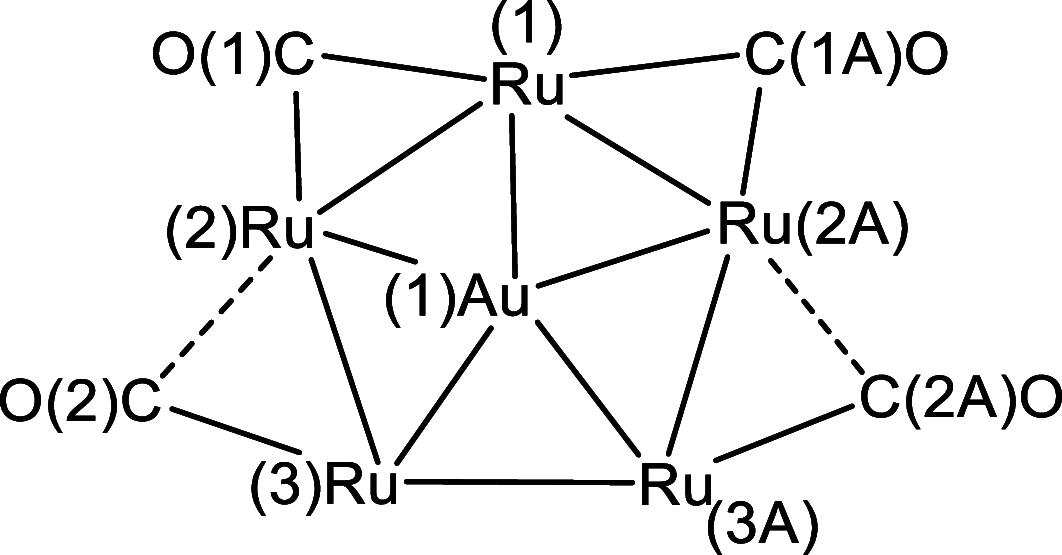2-D Molecular Alloy Ru-M (M = Cu, Ag, and Au) Carbonyl Clusters: Synthesis, Molecular Structure, Catalysis, and Computational Studies
- PMID: 36069711
- PMCID: PMC9490753
- DOI: 10.1021/acs.inorgchem.2c02099
2-D Molecular Alloy Ru-M (M = Cu, Ag, and Au) Carbonyl Clusters: Synthesis, Molecular Structure, Catalysis, and Computational Studies
Abstract
The reactions of [HRu3(CO)11]- (1) with M(I) (M = Cu, Ag, and Au) compounds such as [Cu(CH3CN)4][BF4], AgNO3, and Au(Et2S)Cl afford the 2-D molecular alloy clusters [CuRu6(CO)22]- (2), [AgRu6(CO)22]- (3), and [AuRu5(CO)19]- (4), respectively. The reactions of 2-4 with PPh3 result in mixtures of products, among which [Cu2Ru8(CO)26]2- (5), Ru4(CO)12(CuPPh3)4 (6), Ru4(CO)12(AgPPh3)4 (7), Ru(CO)3(PPh3)2 (8), and HRu3(OH)(CO)7(PPh3)3 (9) have been isolated and characterized. The molecular structures of 2-6 and 9 have been determined by single-crystal X-ray diffraction. The metal-metal bonding within 2-5 has been computationally investigated by density functional theory methods. In addition, the [NEt4]+ salts of 2-4 have been tested as catalyst precursors for transfer hydrogenation on the model substrate 4-fluoroacetophenone using iPrOH as a solvent and a hydrogen source.
Conflict of interest statement
The authors declare no competing financial interest.
Figures


















Similar articles
-
Polymerization Isomerism in Co-M (M = Cu, Ag, Au) Carbonyl Clusters: Synthesis, Structures and Computational Investigation.Molecules. 2021 Mar 11;26(6):1529. doi: 10.3390/molecules26061529. Molecules. 2021. PMID: 33799629 Free PMC article.
-
Synthesis, Structural Characterization, and DFT Investigations of [MxM'5-xFe4(CO)16]3- (M, M' = Cu, Ag, Au; M ≠ M') 2-D Molecular Alloy Clusters.Inorg Chem. 2020 Nov 2;59(21):15936-15952. doi: 10.1021/acs.inorgchem.0c02443. Epub 2020 Oct 20. Inorg Chem. 2020. PMID: 33081462 Free PMC article.
-
Reactions of trinuclear platinum clusters with electrophiles: ionisation isomerism with [Pt3(μ2-I)(μ-PPh2)2(PPh3)3]I and [Pt3(μ-PPh2)2I2(PPh3)3]. Structures of [Pt3(μ2-Cl)(μ-PPh2)2(PPh3)3]PF6, [Pt3(μ-PPh2)2I2(PPh3)3] and of the Pt-Ag cluster [Pt3{μ3-AgBF4}(μ2-I)(μ-PPh2)2(PPh3)3]BF4.Dalton Trans. 2014 Jun 21;43(23):8609-19. doi: 10.1039/c4dt00090k. Dalton Trans. 2014. PMID: 24760124
-
Thermal Growth of Au-Fe Heterometallic Carbonyl Clusters Containing N-Heterocyclic Carbene and Phosphine Ligands.Inorg Chem. 2020 Feb 17;59(4):2228-2240. doi: 10.1021/acs.inorgchem.9b02912. Epub 2020 Jan 31. Inorg Chem. 2020. PMID: 32003563 Free PMC article.
-
Highly Reduced Ruthenium Carbide Carbonyl Clusters: Synthesis, Molecular Structure, Reactivity, Electrochemistry, and Computational Investigation of [Ru6C(CO)15]4.Inorg Chem. 2023 Sep 11;62(36):14590-14603. doi: 10.1021/acs.inorgchem.3c01711. Epub 2023 Aug 30. Inorg Chem. 2023. PMID: 37646082 Free PMC article.
Cited by
-
Chemical Bonding Topology of Metal-Centered Polygonal Wheels: Two-Dimensional Analogues of Metallaboranes Related to Benzene and Cyclopentadienide.Inorg Chem. 2023 Apr 3;62(13):5248-5252. doi: 10.1021/acs.inorgchem.3c00267. Epub 2023 Mar 23. Inorg Chem. 2023. PMID: 36952325 Free PMC article.
References
-
- Zacchini S. Using Metal Carbonyl Clusters To Develop a Molecular Approach towards Metal Nanoparticles. Eur. J. Inorg. Chem. 2011, 2011, 4125–4145. 10.1002/ejic.201100462. - DOI
LinkOut - more resources
Full Text Sources
Miscellaneous

